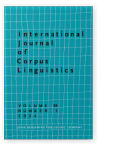Vol. 29:1 (2024) ► pp.34–58
Concordancing for CADS
Practical challenges and theoretical implications
Concordance analysis is widely recognised as one of the main techniques in a corpus linguist’s toolkit. However, despite a growing body of work critically exploring previously unquestioned mainstays of corpus methods (Mautner, 2015; Taylor & Marchi, 2018), this has not focused on concordance analysis specifically. In this paper, we aim to discuss issues that researchers may encounter when interpreting concordances. We begin in Step One with a cursory examination of 800 concordance lines in order to identify potential issues. In Step Two, we assess the distribution of those issues in a reduced sample of 200. As a result, we identify eight interpretability issues: noise in the corpus, non-standard syntax, unclear referring expressions, unclear quotation source attribution, technical terms/jargon, acronyms/initialisms, unspecific co-text, and lines unrelated to the research question. After reflecting on practical challenges, we discuss the epistemological implications of removing concordance lines uncritically and suggest ten recommendations for future work.
Article outline
- 1.Introduction
- 2.Analysing concordances
- 2.1The concordance line: A useful artefact
- 2.2Reflections on procedure
- 2.3Types of concordance analysis
- 3.Our research design
- 4.Findings
- 4.1Step One: Cursory examination of 800 concordance lines
- 4.2Step Two: Categorising interpretability issues
- 5.Epistemological implications
- 6.Conclusions
- Acknowledgements
- Notes
-
References
For any use beyond this license, please contact the publisher at [email protected].
